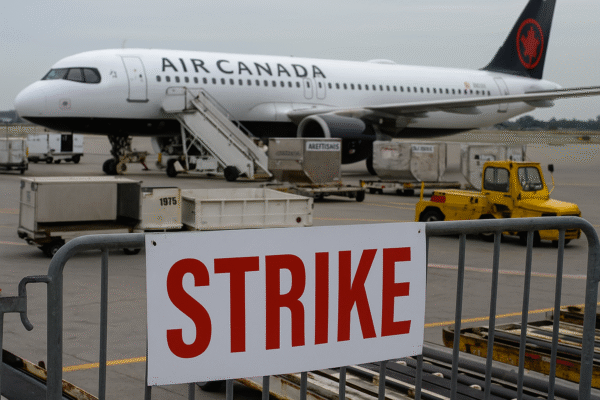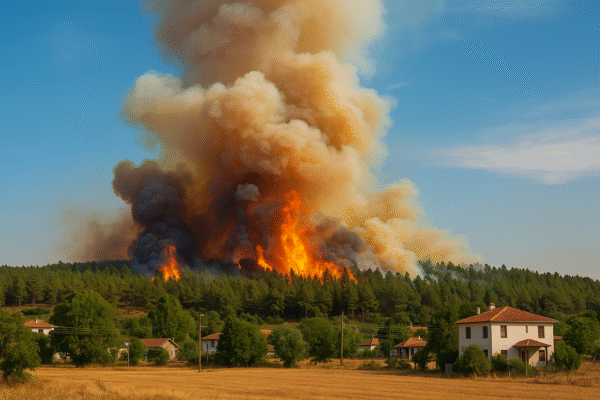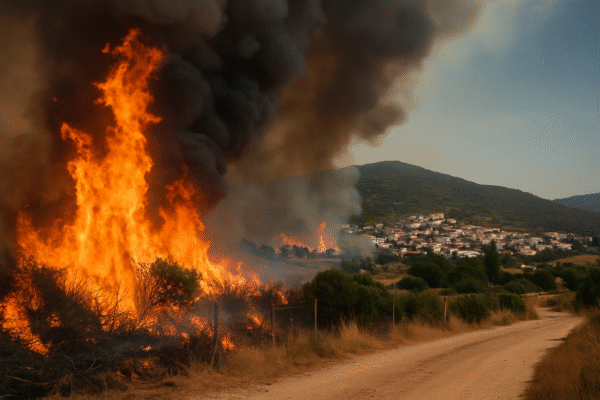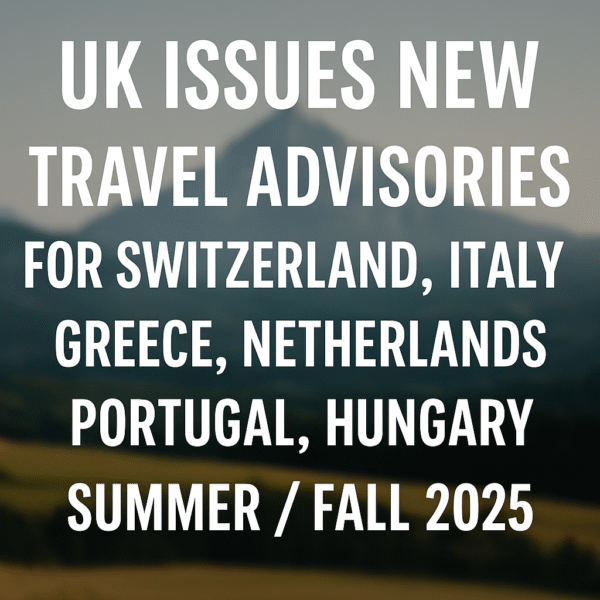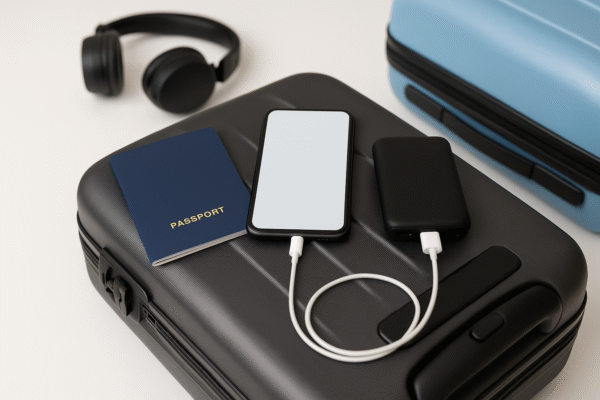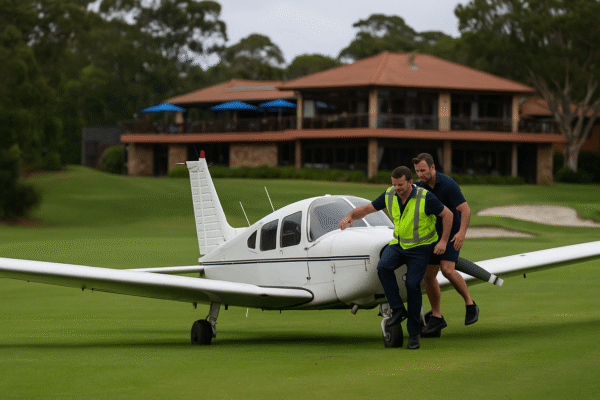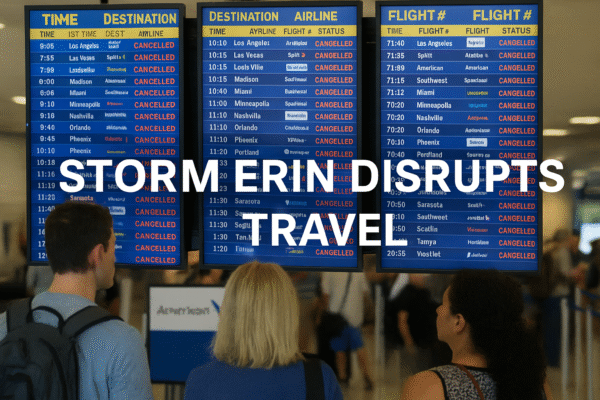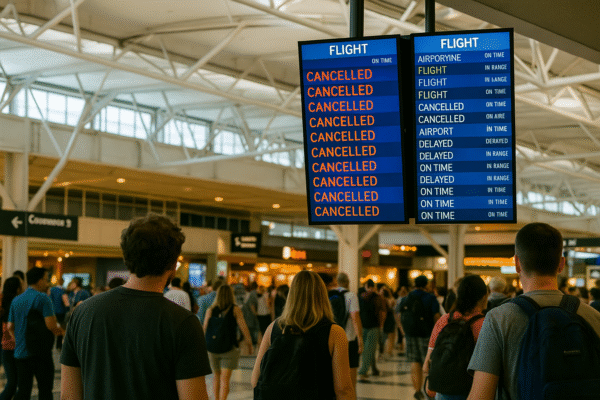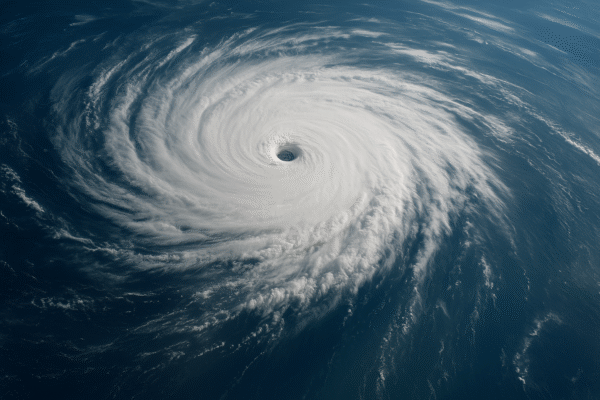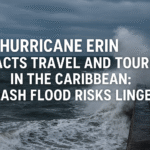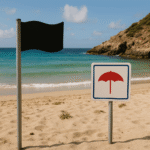The Atlantic hurricane season has taken a dramatic turn as Hurricane Erin rapidly intensified into a Category 5 storm, with maximum sustained winds reaching 160 mph (260 km/h). As the cyclone charts a path north of the Leeward Islands, Puerto Rico, and the US Virgin Islands, its impact is already reverberating throughout the Caribbean tourism industry and along the eastern coastline of the United States.
While no direct landfall is currently forecast, the storm’s outer bands are unleashing heavy rain, hazardous surf, and flash flooding risks. From beach resorts in Puerto Rico to cruise ports in the Bahamas and surf zones in North Carolina, Hurricane Erin is severely affecting both local economies and international travel.
🌊 Caribbean Hit by Dangerous Weather: Rainfall, Mudslides & Travel Chaos
Caribbean hotspots are among the first to face the brunt of Hurricane Erin’s wrath. The US National Hurricane Center (NHC) has issued weather alerts across Puerto Rico, St. Thomas, and the southeastern Bahamas, warning of up to six inches (15 cm) of rainfall and possible mudslides in mountainous areas.
For tourists vacationing in these destinations, the tropical paradise has become a logistical nightmare. Flight cancellations, cruise itinerary changes, and hotel evacuations are now common as operators shift gears to manage the ongoing crisis. Many beach activities, coastal tours, and water sports have been suspended until further notice.
🛳️ Port Closures & Travel Advisories
The US Coast Guard has imposed restrictions on vessel operations in key ports, including San Juan, Charlotte Amalie, and parts of the British Virgin Islands. Gale-force winds are expected to escalate, making travel by sea increasingly dangerous.
Airlines have begun cancelling outbound flights from Puerto Rico and redirecting arrivals to safer airports. Cruise companies such as Royal Caribbean and Carnival have rerouted ships, impacting travelers embarking from Miami, Orlando, and Fort Lauderdale.
Travelers are advised to monitor advisories from the NHC, the Federal Emergency Management Agency (FEMA), and local tourism boards. Some travel insurance providers are now offering hurricane disruption coverage for those affected.
🏖️ U.S. East Coast Braces for Dangerous Surf
Although Hurricane Erin is not projected to make landfall on the US mainland, coastal areas from Florida to North Carolina are already experiencing strong swells and rip currents. The Outer Banks—a major summer hotspot—has closed public beaches, warning swimmers and surfers of treacherous wave conditions.
The storm’s influence stretches further to Bermuda, where maritime warnings have been issued, potentially delaying ferry services and local tourism excursions.
These surf warnings are especially significant given that August is a peak travel period for both domestic and international tourists. Affected areas are expected to see disruptions in accommodation occupancy, beach activities, and event tourism.
💸 Economic Toll on Tourism: Short-Term Setbacks
Tourism-dependent economies such as Puerto Rico, the US Virgin Islands, and the Bahamas are particularly vulnerable to natural disasters like Hurricane Erin. The storm’s timing—smack in the middle of the summer travel season—could have serious implications for local businesses relying on international visitors.
Hospitality industry insiders estimate that millions in lost revenue could result from this event due to cancellations, reduced tourist footfall, and infrastructure damage.
The ripple effects could extend into the fall, as post-storm recovery typically includes environmental cleanups, repair of coastal roads, and rebuilding of damaged resorts.
🧭 Safety Tips for Tourists in Affected Areas
For those still in or heading to hurricane-affected zones, preparation is key:
- Stay Updated: Use trusted sources such as the NHC, FEMA, and local meteorological agencies.
- Avoid Risk Areas: Delay travel to flood-prone regions or coastal destinations under advisories.
- Follow Local Authorities: Obey evacuation notices and shelter instructions.
- Travel Insurance: Ensure your coverage includes natural disasters and weather-related trip disruptions.
- Emergency Kits: Keep essentials such as bottled water, non-perishable food, medication, and chargers on hand.
🌍 Long-Term Outlook: Adapting to Climate Realities
Hurricane Erin’s sudden leap to Category 5 status mirrors a worrying trend: the increasing frequency and strength of Atlantic hurricanes due to climate change. Warmer ocean temperatures provide more fuel for storms, resulting in extreme weather events that are both unpredictable and severe.
Experts from the NOAA and World Meteorological Organization stress the importance of climate adaptation for tourism. Upgrading infrastructure, enhancing emergency response systems, and implementing climate-smart policies are critical to ensuring both visitor safety and economic resilience in vulnerable regions.
🧳 Final Word: Travel Smart, Stay Safe
While Hurricane Erin may not directly hit the US mainland, its powerful outer effects serve as a critical reminder: traveling during hurricane season requires vigilance. Tourists are encouraged to plan wisely, choose flexible booking options, and remain prepared for sudden weather changes.
As the Caribbean and US East Coast brace for the rest of the 2025 storm season, the focus must remain on safety, resilience, and responsible travel.
For more travel news like this, keep reading Global Travel Wire




